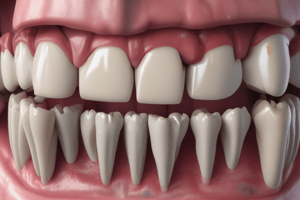Podcast
Questions and Answers
What happens if epithelium proliferates along the tooth surface before the other tissues reach the area during pocket healing?
What happens if epithelium proliferates along the tooth surface before the other tissues reach the area during pocket healing?
- New formation of cementum and PDL
- Root resorption and ankylosis
- Fibers parallel to the tooth surface and remodeling of the alveolar bone
- A long junctional epithelium (correct)
What is the ideal outcome of periodontal therapy?
What is the ideal outcome of periodontal therapy?
- New formation of cementum and PDL (correct)
- Long junctional epithelium
- Recurrence of pocket
- Root resorption and ankylosis
What is the limitation of radiographic methods in evaluating new attachment and bone regeneration?
What is the limitation of radiographic methods in evaluating new attachment and bone regeneration?
- Unreliability compared to clinical probing technique (correct)
- Lack of reproducibility
- Difficulty in comparing pre and post treatment records
- Insensitivity to recognize a sufficient loss at the alveolar crest
What are the two disadvantages of surgical re-entry in evaluating new attachment and bone regeneration?
What are the two disadvantages of surgical re-entry in evaluating new attachment and bone regeneration?
What is the only method that can determine the type of attachment?
What is the only method that can determine the type of attachment?
What happens if bone cells arrive first during pocket healing?
What happens if bone cells arrive first during pocket healing?
What is the purpose of comparing pre and post treatment records in evaluating new attachment and bone regeneration?
What is the purpose of comparing pre and post treatment records in evaluating new attachment and bone regeneration?
What is the result if cells from the gingival connective tissue arrive first during pocket healing?
What is the result if cells from the gingival connective tissue arrive first during pocket healing?
What is the advantage of clinical methods in evaluating new attachment and bone regeneration?
What is the advantage of clinical methods in evaluating new attachment and bone regeneration?
What is the purpose of taking repeated impressions during surgical re-entry?
What is the purpose of taking repeated impressions during surgical re-entry?
Flashcards are hidden until you start studying
Study Notes
Connective Tissue and Periodontal Cells
- Connective tissue, PDL, bone, and cementum are derived from undifferentiated connective tissue cells.
- These cells develop into fibroblasts, osteoblasts, and cementoblasts.
Regeneration of the Periodontium
- Regeneration is a continuous physiologic process under normal conditions.
- New cells and tissues are formed to replace mature and dead cells.
- This process is termed "wear and tear repair".
Regeneration during Destructive Periodontal Disease
- Gingival and periodontal diseases are chronic inflammatory conditions that involve healing processes.
- Bacteria and bacterial products prevent healing from proceeding to completion.
- When bacterial plaque is removed, the inherent regenerative capacity of tissues is established.
Repair and Healing
- Repair is the restoration of the continuity of the diseased marginal gingiva.
- It involves the reestablishment of a normal gingival sulcus at the same level as the base of a preexisting pocket.
- This process is called "healing by scar".
- Bone loss is arrested with mobilization of epithelial and connective tissue cells into the damaged area.
New Attachment and Reattachment
- New attachment is the embedding of new PDL fibers into new cementum and attachment of epithelium to a tooth surface.
- Reattachment is not the correct term, as new fibers are formed and attach to new cementum.
- Reattachment refers to repair in areas of the root not previously exposed to pockets.
Animal Studies
- Animal studies can be used to evaluate periodontal regeneration and new attachment.
- This method involves extraction of the examined tooth with its periodontium after successful treatment.
Reconstructive Surgical Techniques
- Reconstructive techniques can be subdivided into three major therapeutic approaches:
- Non-bone graft-associated
- Graft-associated
- Biologic mediator-associated
- Clinicians often combine these approaches in clinical practice.
Non-Graft-Associated Reconstructive Procedures
- These procedures aim to achieve new attachment or periodontal bone regeneration.
- GTR (Guided Tissue Regeneration) is the main procedure used in clinical practice.
- Laser-assisted new attachment procedure (LANAP) may also result in new attachment and regeneration.
Guided Tissue Regeneration (GTR)
- GTR is used to prevent epithelial migration along the cemental wall of the pocket.
- It maintains space for clot stabilization.
- GTR involves placing barriers (membranes) to cover the bone and periodontal ligament, excluding the epithelium and gingival connective tissue.
Principles of Non-Graft New Attachment
- Complete removal of all irritants with or without exposure of the area with a flap.
- Occlusal adjustment may be indicated if there is trauma from occlusion.
- The possible outcomes of therapy depend on which cells populate the area first:
- Epithelial cells: long junctional epithelium
- Gingival connective tissue cells: fibers parallel to the tooth surface and remodeling of the alveolar bone
- Bone cells: root resorption and ankylosis
- Periodontal ligament cells: new formation of cementum and PDL (new attachment)
Evaluation of New Attachment and Bone Regeneration
- Clinical methods: comparison of pre and post treatment records of pocket probing, attachment level, gingival indices, and alveolar bone level.
- Radiographic methods: standardized technique is needed for reproducible positioning of the film and the tube.
- Surgical re-entry: evaluation can be performed by taking repeated impressions.
- Histologic methods: type of attachment can be determined only by histologic analysis of tissue blocks obtained from the healed area.
Studying That Suits You
Use AI to generate personalized quizzes and flashcards to suit your learning preferences.




